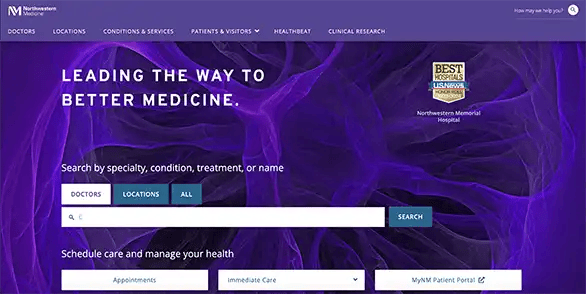The design of healthcare websites plays a pivotal role in how patients and healthcare professionals access and interact with healthcare resources and services. Here we provide our top picks for hospital website design.
The Importance of UX in Healthcare Website Design
The user experience (UX) on these sites, from large healthcare institutions like Harvard Medical School to local hospital websites, is crucial for ensuring that users find the information and services they need efficiently. For healthcare providers, ensuring their website is user-friendly and accessible on mobile devices is not just about creating a digital presence but about enhancing patient care and engagement.
Effective healthcare website design is not just about aesthetics; it involves understanding the unique needs of the healthcare industry's target audience, which includes patients seeking treatment options, healthcare professionals looking for research and news, and visitors searching for healthcare services across multiple locations. The goal is to make these websites as responsive and mobile-friendly as possible, acknowledging that many users will access these resources on the go. Websites like those of major medical centers must prioritize fast loading times, clean design, and easy navigation to cater to the needs of potential patients, doctors, and other healthcare service seekers.
Our Top Picks for Hospital Websites
If you are designing a website for a hospital or healthcare facility, you need to make sure that your website is user-friendly. Because these websites are so often used by people in distress, users must be treated with empathy and guided to accomplish three tasks easily:
1) Find the right health provider to get treatment
2) Retrieve medical records, such as test results and other health information
3) Pay their bills
What do all of these things have in common? They all require a thorough understanding of UX best practices. If your primary users can't navigate the website easily and accomplish their goals, your website won't be a success. After looking at many healthcare websites, here are my picks for the best 12 hospital websites:












The importance of UX in medical website design extends to the specifics of healthcare information dissemination and patient engagement. Features such as appointment scheduling, access to test results, and the presentation of healthcare options—from orthopedic services to general patient care—need to be straightforward and user-friendly. A hospital's website, for instance, must not only showcase its array of services and treatments but also provide a seamless way for patients to connect with healthcare providers, whether for immediate needs or ongoing health system engagement.
The user experience of healthcare websites—from a single landing page to an entire site's structure—significantly impacts how healthcare resources are accessed and utilized by the community. As the healthcare industry continues to evolve, so too must the approach to healthcare website design, ensuring it remains responsive to the needs of its diverse user base, from patients to healthcare professionals, enhancing the overall quality of healthcare services and patient outcomes.



